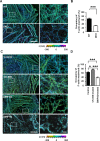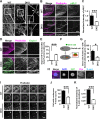mDia1/3 generate cortical F-actin meshwork in Sertoli cells that is continuous with contractile F-actin bundles and indispensable for spermatogenesis and male fertility
- PMID: 30256801
- PMCID: PMC6175529
- DOI: 10.1371/journal.pbio.2004874
mDia1/3 generate cortical F-actin meshwork in Sertoli cells that is continuous with contractile F-actin bundles and indispensable for spermatogenesis and male fertility
Abstract
Formin is one of the two major classes of actin binding proteins (ABPs) with nucleation and polymerization activity. However, despite advances in our understanding of its biochemical activity, whether and how formins generate specific architecture of the actin cytoskeleton and function in a physiological context in vivo remain largely obscure. It is also unknown how actin filaments generated by formins interact with other ABPs in the cell. Here, we combine genetic manipulation of formins mammalian diaphanous homolog1 (mDia1) and 3 (mDia3) with superresolution microscopy and single-molecule imaging, and show that the formins mDia1 and mDia3 are dominantly expressed in Sertoli cells of mouse seminiferous tubule and together generate a highly dynamic cortical filamentous actin (F-actin) meshwork that is continuous with the contractile actomyosin bundles. Loss of mDia1/3 impaired these F-actin architectures, induced ectopic noncontractile espin1-containing F-actin bundles, and disrupted Sertoli cell-germ cell interaction, resulting in impaired spermatogenesis. These results together demonstrate the previously unsuspected mDia-dependent regulatory mechanism of cortical F-actin that is indispensable for mammalian sperm development and male fertility.
Conflict of interest statement
DT and SN were supported by the Coordination Fund from MEXT and Astellas Pharma. SN is a scientific advisor to Astellas Pharma. Other authors declare that they have no conflicts of interest.
Figures





Similar articles
-
Mechanostress resistance involving formin homology proteins: G- and F-actin homeostasis-driven filament nucleation and helical polymerization-mediated actin polymer stabilization.Biochem Biophys Res Commun. 2018 Nov 25;506(2):323-329. doi: 10.1016/j.bbrc.2018.09.189. Epub 2018 Oct 9. Biochem Biophys Res Commun. 2018. PMID: 30309655 Review.
-
Actin filament bundling and different nucleating effects of mouse Diaphanous-related formin FH2 domains on actin/ADF and actin/cofilin complexes.J Mol Biol. 2010 Nov 5;403(4):529-45. doi: 10.1016/j.jmb.2010.09.017. Epub 2010 Oct 1. J Mol Biol. 2010. PMID: 20869367
-
The filamentous actin cross-linking/bundling activity of mammalian formins.J Mol Biol. 2008 Dec 12;384(2):324-34. doi: 10.1016/j.jmb.2008.09.043. Epub 2008 Sep 26. J Mol Biol. 2008. PMID: 18835565
-
Deficiency of mDia, an actin nucleator, disrupts integrity of neuroepithelium and causes periventricular dysplasia.PLoS One. 2011;6(9):e25465. doi: 10.1371/journal.pone.0025465. Epub 2011 Sep 28. PLoS One. 2011. PMID: 21980468 Free PMC article.
-
mDia1 and formins: screw cap of the actin filament.Biophysics (Nagoya-shi). 2012 May 31;8:95-102. doi: 10.2142/biophysics.8.95. eCollection 2012. Biophysics (Nagoya-shi). 2012. PMID: 27493525 Free PMC article. Review.
Cited by
-
Decisive role of mDia-family formins in cell cortex function of highly adherent cells.Sci Adv. 2024 Nov;10(44):eadp5929. doi: 10.1126/sciadv.adp5929. Epub 2024 Oct 30. Sci Adv. 2024. PMID: 39475610 Free PMC article.
-
Functional integrity of the contractile actin cortex is safeguarded by multiple Diaphanous-related formins.Proc Natl Acad Sci U S A. 2019 Feb 26;116(9):3594-3603. doi: 10.1073/pnas.1821638116. Epub 2019 Feb 11. Proc Natl Acad Sci U S A. 2019. PMID: 30808751 Free PMC article.
-
Recapitulating Actin Module Organization in the Drosophila Oocyte Reveals New Roles for Bristle-Actin-Modulating Proteins.Int J Mol Sci. 2021 Apr 13;22(8):4006. doi: 10.3390/ijms22084006. Int J Mol Sci. 2021. PMID: 33924532 Free PMC article.
-
Hierarchical morphogenesis of swallowtail butterfly wing scale nanostructures.Elife. 2023 Sep 28;12:RP89082. doi: 10.7554/eLife.89082. Elife. 2023. PMID: 37768710 Free PMC article.
-
Epidermal growth factor receptor signaling uncouples germ cells from the somatic follicular compartment at ovulation.Nat Commun. 2021 Mar 4;12(1):1438. doi: 10.1038/s41467-021-21644-z. Nat Commun. 2021. PMID: 33664246 Free PMC article.
References
Publication types
MeSH terms
Substances
LinkOut - more resources
Full Text Sources
Other Literature Sources
Molecular Biology Databases

